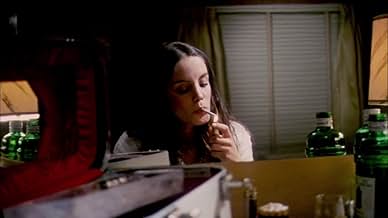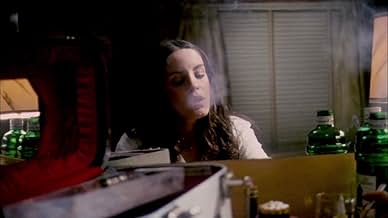Aggiungi una trama nella tua linguaA beautiful stripper hires renowned criminals to exact revenge on those who raped her in her motel room.A beautiful stripper hires renowned criminals to exact revenge on those who raped her in her motel room.A beautiful stripper hires renowned criminals to exact revenge on those who raped her in her motel room.
- Regia
- Sceneggiatura
- Star
Recensioni in evidenza
"Gina," a Canadian film from 1975, is a curious beast. On the surface, it ticks all the boxes of a typical rape-revenge exploitation film of its era. However, beneath the surface, it offers a unique and compelling narrative that explores broader ideas and themes.
The story follows the title character, Gina, a stripper who is sent to perform at a rural bar in the middle of winter. When she is brutally attacked, she embarks on a violent mission of revenge with the help of her pimp and their henchmen.
What sets "Gina" apart from its contemporaries is director and co-writer Denys Arcand's approach to the material. Arcand, known for his thought-provoking films like "The Barbarian Invasions," uses the exploitative elements as a hook to delve into deeper territory. The sex and violence are undeniably attention-grabbing, but they serve a greater purpose in this film.
"Gina" is an intriguing blend of arthouse and grindhouse. It's a film that challenges its audience, offering a unique take on the revenge narrative. The grit and grime of the setting and the brutal nature of the story are juxtaposed with a thoughtful exploration of human nature and the consequences of violence.
However, despite its ambitious approach, "Gina" falls short of being a truly remarkable film. While it has its moments of brilliance, the overall execution feels uneven. The pacing is often sluggish, and the tone veers wildly from one scene to the next. It is a film that keeps you engaged, but more in the sense of curiosity about where it will go next rather than genuine investment in the characters or their journeys.
That being said, "Gina" is worth watching for those interested in the evolution of exploitation cinema and its intersections with arthouse storytelling. The film's supplementary features, including interviews with Arcand and cast members, as well as a video essay by rape-revenge film scholar Alexandra Heller-Nicholar, provide valuable context and insights into the film's creation and impact.
In conclusion, "Gina" is a fascinating experiment in genre filmmaking that, while not entirely successful, offers a unique and thought-provoking experience.
The story follows the title character, Gina, a stripper who is sent to perform at a rural bar in the middle of winter. When she is brutally attacked, she embarks on a violent mission of revenge with the help of her pimp and their henchmen.
What sets "Gina" apart from its contemporaries is director and co-writer Denys Arcand's approach to the material. Arcand, known for his thought-provoking films like "The Barbarian Invasions," uses the exploitative elements as a hook to delve into deeper territory. The sex and violence are undeniably attention-grabbing, but they serve a greater purpose in this film.
"Gina" is an intriguing blend of arthouse and grindhouse. It's a film that challenges its audience, offering a unique take on the revenge narrative. The grit and grime of the setting and the brutal nature of the story are juxtaposed with a thoughtful exploration of human nature and the consequences of violence.
However, despite its ambitious approach, "Gina" falls short of being a truly remarkable film. While it has its moments of brilliance, the overall execution feels uneven. The pacing is often sluggish, and the tone veers wildly from one scene to the next. It is a film that keeps you engaged, but more in the sense of curiosity about where it will go next rather than genuine investment in the characters or their journeys.
That being said, "Gina" is worth watching for those interested in the evolution of exploitation cinema and its intersections with arthouse storytelling. The film's supplementary features, including interviews with Arcand and cast members, as well as a video essay by rape-revenge film scholar Alexandra Heller-Nicholar, provide valuable context and insights into the film's creation and impact.
In conclusion, "Gina" is a fascinating experiment in genre filmmaking that, while not entirely successful, offers a unique and thought-provoking experience.
Denys Arcand's "Gina" (1975) is a film that defies easy categorization. It's a vengeance thriller fueled by a brutal assault, set against the backdrop of a bleak Canadian winter and interwoven with a social commentary on labor exploitation. While undeniably compelling, "Gina" stumbles with uneven pacing and a tonal shift that may leave some viewers wanting more.
The film centers around Gina, a captivating yet vulnerable stripper (Céline Lomez), forced to perform at a seedy motel. Her arrival coincides with a documentary crew exploring the harsh realities of a local textile mill. Interweaving documentary and fictional elements, Arcand paints a picture of a community struggling with economic hardship. This social commentary adds depth, but can feel disjointed at times.
The narrative takes a sharp turn when Gina is attacked by a group of snowmobile-riding thugs. This brutal scene is unflinching and sets the stage for Gina's chilling quest for revenge. Arcand masterfully utilizes the desolate winter landscape, creating a sense of isolation that amplifies the film's emotional impact. However, the pacing can feel slow, particularly in the first act, as the film establishes its characters and setting.
The true strength of "Gina" lies in its exploration of female agency. Here's a woman wronged, who refuses to be a victim. She seeks out a notorious Montreal gang to enact her revenge, a decision fraught with danger and moral ambiguity. Lomez delivers a powerful performance, capturing Gina's vulnerability, resilience, and steely resolve.
The final act explodes with a brutal and bloody showdown, complete with a show-stopping snowmobile chase. This visceral sequence is undeniably thrilling, but feels somewhat tonally incongruous with the film's more measured social commentary.
"Gina" is a fascinating and flawed film. It's a must-see for fans of Canadian cinema and those interested in a unique take on the revenge genre. However, viewers seeking a consistently paced and tightly focused narrative may find themselves wanting.
The film centers around Gina, a captivating yet vulnerable stripper (Céline Lomez), forced to perform at a seedy motel. Her arrival coincides with a documentary crew exploring the harsh realities of a local textile mill. Interweaving documentary and fictional elements, Arcand paints a picture of a community struggling with economic hardship. This social commentary adds depth, but can feel disjointed at times.
The narrative takes a sharp turn when Gina is attacked by a group of snowmobile-riding thugs. This brutal scene is unflinching and sets the stage for Gina's chilling quest for revenge. Arcand masterfully utilizes the desolate winter landscape, creating a sense of isolation that amplifies the film's emotional impact. However, the pacing can feel slow, particularly in the first act, as the film establishes its characters and setting.
The true strength of "Gina" lies in its exploration of female agency. Here's a woman wronged, who refuses to be a victim. She seeks out a notorious Montreal gang to enact her revenge, a decision fraught with danger and moral ambiguity. Lomez delivers a powerful performance, capturing Gina's vulnerability, resilience, and steely resolve.
The final act explodes with a brutal and bloody showdown, complete with a show-stopping snowmobile chase. This visceral sequence is undeniably thrilling, but feels somewhat tonally incongruous with the film's more measured social commentary.
"Gina" is a fascinating and flawed film. It's a must-see for fans of Canadian cinema and those interested in a unique take on the revenge genre. However, viewers seeking a consistently paced and tightly focused narrative may find themselves wanting.
"Gina" (1975) is an uneven combination of social docudrama about the working classes of Quebec and a rape-and-revenge story. For most of its running time it doesn't seem to be going anywhere, but a slam-bang action (and gore) climax redeems it somewhat. Celine Lomez's beauty and the snowy landscapes are further assets (the single greatest visual of the film may be a large, abandoned ship on a frozen river), but on the whole "Gina" is a film mostly of interest to director Denys Arcand followers: he didn't hit the big time until 11 years later, with "The Decline Of The American Empire". **1/2 out of 4.
In the 1970's, in Quebec, everybody's was making movies? Don't have a budget, don't have a story, don't have actors? Who cares? Let's make movies! There were good ones : Mon oncle Antoine, JA Martin photographe, Les Ordres. But there were the bad, and the very very very bad. The bad ones have all the elements of Gina : lousy French speaking, men drinking beer all the time, vulgarity, very cheap settings. Viewing this, it's hard to believe that Denys Arcand will become one of the finiest movie director of Canada in the 1980's. But it's got the elements of a Arcand film. Perhaps it was fine to watch this in 1974 : today, it's seems very old and very boring.
To the best of my knowledge, there is no English version of this film, aside from subtitles, which I had to find on the internet (my DVD was completely in French), thus dooming this film to a higher level of obscurity than it deserves. It's a good movie and, while some might write if off as an exploitation flick, it's a little more cerebral than that and deserves a little more credit. The general bleakness and crumminess of the hotel and the town itself were things I could really relate to and the way that all the characters are portrayed as victims of some sort of oppression beyond their control provides a nice commentary on the human condition that I appreciate seeing in a film. There are no real winners in Gina and it is not a feel-good film by any means, nor is it a bummer, either. Everyone is getting screwed by someone and everyone is making do with their lot in the best way they know how in a manner that I think rings true with a lot of people, and then you get the treat of an over-the-top shlock-fest of an ending that is the icing on the cake. They certainly don't make them like this anymore and, if you are like me and despise most of the garbage movies they put out these days but loved the trash from the 70's and 80's, this one will not disappoint. A great film and worth seeking out.
Lo sapevi?
- ConnessioniReferences Su e giù per le scale (1959)
I più visti
Accedi per valutare e creare un elenco di titoli salvati per ottenere consigli personalizzati
- How long is Gina?Powered by Alexa
Dettagli
Botteghino
- Budget
- 360.000 CA$ (previsto)
- Tempo di esecuzione
- 1h 35min(95 min)
- Colore
- Proporzioni
- 1.85 : 1
Contribuisci a questa pagina
Suggerisci una modifica o aggiungi i contenuti mancanti






























